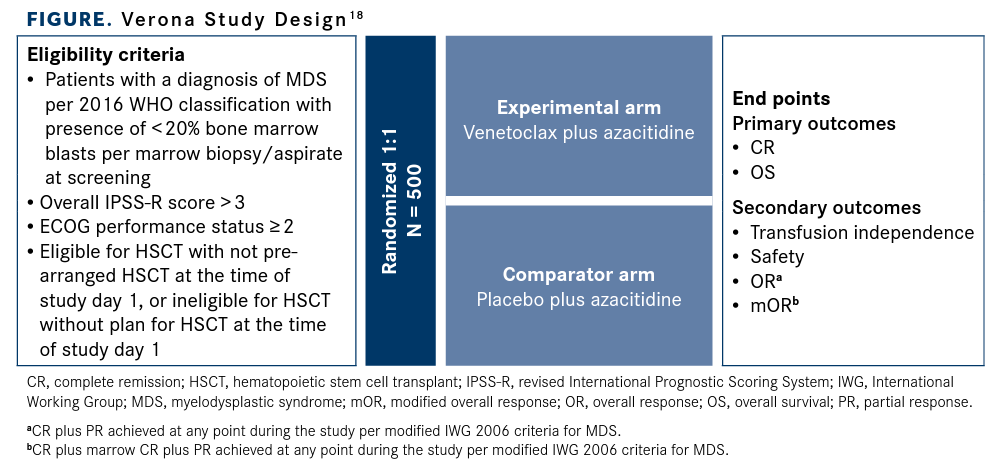Publication
Article
Novel Agents Shake Up Myelodysplastic Syndrome Treatment Landscape
Author(s):
During a recent OncLive Peer Exchange®, a panel of hematologic cancer experts shared their insights on the most recent FDA-approved agents for MDS, including luspatercept and decitabine/cedazuridine (Inqovi), both of which were approved in 2020.
Gail J. Roboz, MD

Myelodysplastic syndrome (MDS) refers to a heterogeneous group of closely related clonal disorders of hematopoietic stem cells that lead to dysplasia and ineffective hematopoiesis in the bone marrow, with older patients (> 65 years) most frequently affected.1 The disease course is variable and not all patients may require treatment initially, particularly if they are asymptomatic. In 2017, the World Health Organization published a revised classification of myeloid neoplasms to incorporate genetic information, which resulted in broadening the subset of cases classified as MDS with ring sideroblasts, and to improve patient risk stratification to enable better overall treatment.2 More recently, several agents for specific patient subgroups have been approved by the FDA, including for patients with very low-risk to high-risk MDS, and many other novel agents with unique mechanisms of action are on the horizon.
During a recent OncLive Peer Exchange®, a panel of hematologic cancer experts shared their insights on the most recent FDA-approved agents for MDS, including luspatercept (Reblozyl) and decitabine/cedazuridine (Inqovi), both of which were approved in 2020.3,4 They also examined some novel emerging treatments, including pevonedistat, magrolimab, and venetoclax (Venclexta), all 3 of which have been granted FDA breakthrough therapy designation as MDS treatments for patients with higher-risk disease,5-7 although pevonedistat’s future in MDS has become uncertain because it recently missed achieving its primary end point of event-free survival (EFS) in the phase 3 PANTHER trial (NCT03268954).8
Rami Komrokji, MD

Luspatercept
Luspatercept is a first-in-class erythroid maturation agent.9 Impaired erythroid maturation contrib-utes to ineffective erythropoiesis, resulting in low production of red blood cells (RBCs) and anemia. Luspatercept enhances late-stage erythropoiesis by binding several endogenous transforming growth factor-β superfamily ligands, thereby diminishing SMAD2/3 signaling.9 SMAD2/3 proteins have been found to be constitutively acti-vated and overexpressed in MDS bone marrow precursors.10
“The exciting thing about luspatercept is that it was the first drug we got approved for MDS [in over a decade], so that by itself is a milestone for all the people who have worked on this,” Rami Komrokji, MD, said. Luspatercept is approved for the treatment of anemia failing an erythropoiesis-stimulating agent and requiring at least 2 RBC units over 8 weeks in adult patients with very low–risk to intermediate-risk MDS with ring sideroblasts or with myelodysplastic/myeloproliferative neoplasms with ring sideroblasts and thrombocytosis.9
The FDA approval of luspatercept was based on data from the double-blind phase 3 MEDALIST trial (NCT02631070), which randomly assigned 229 patients with very low–risk, low-risk, or intermediate-risk MDS with ring sideroblasts requiring regular RBC transfusions to receive either luspatercept at a dosage of 1.0 mg/kg to 1.75 mg/kg (n = 153) or placebo (n = 76), administered subcutaneously every 3 weeks.11 Transfusion independence for at least 8 weeks was achieved in 38% of the patients in the luspatercept arm vs 13% of those in the placebo arm (P < .001). A significantly higher percentage of patients in the luspatercept arm than in the placebo arm met the secondary end point of transfusion independence for at least 12 weeks (28% vs 8%, respectively, for weeks 1 through 24; 33% vs 12%, respectively, for weeks 1 through 48; P < .001 for both comparisons).11
“The real benefit of transfusion independency was in patients who were not heavily transfusion dependent,” Komrokji said. “Once patients get into the 6 to 8 units every other month, those patients may benefit a little bit in transfusion reduction, but not really transfusion independency. So, in my algorithm now, if patients have had an adequate trial of ESA [erythropoietin-stimulating agents] and we are now moving to the next step, I ask whether they have ring sideroblasts. If they do, I try to introduce [luspatercept] a little bit earlier, before the patients are heavily transfusion dependent.”
In the MEDALIST trial, the most common luspatercept-associated adverse events (AEs) of any grade included fatigue, diarrhea, asthenia, nausea, and dizziness, with the incidence of AEs decreasing over time. “We have had a couple of patients who had to come off [treatment], but in general it was very well tolerated,” Komrokji said. He emphasized the importance of following the escalated dosing outlined in the package insert for patients who are not RBC transfusion free after 2 consecutive doses (6 weeks) at the recommended 1-mg/kg starting dose.
Azra Raza, MD

Decitabine/Cedazuridine
Decitabine/cedazuridine is a fixed-dose oral combination therapy that pairs a nucleoside metabolic inhibitor (ie, decitabine) with a novel cytidine deaminase inhibitor (ie, cedazuridine).12 It is indicated for adult patients with previously treated or untreated, de novo and secondary MDS with the following French-American-British subtypes: refractory anemia, refractory anemia with ringed sideroblasts, refractory anemia with excess blasts, and chronic myelomonocytic leukemia (CMML).12 It is also indicated for patients with MDS who fall into intermediate-1, intermediate-2, and high-risk International Prognostic Scoring System groups.
FDA approval of decitabine/cedazuridine was based on data from 2 open-label, randomized, crossover trials: the phase 1/2 ASTX727-01-B trial (NCT02103478), which included 80 adult patients with MDS or CMML, and the phase 3 ASTX727-02 trial (NCT03306264), which included 133 adult patients with MDS or CMML.4 “Pharmacokinetically and from a response perspective, it looks like [decitabine/cedazuridine is] the same as decitabine,” Gail J. Roboz, MD, said. She explained that the addition of cedazuridine allows oral dosing by preventing the decitabine from being completely broken down by the gastrointestinal tract and liver, which would limit decitabine’s oral bioavailability.
In the clinical trials, oral decitabine/ cedazuridine administered as a 100/35-mg fixed-dose tablet was found to provide equivalent decitabine exposure to intravenous (IV) decitabine 20 mg/m2 when both were administered over 5 days.4,13 The decitabine area under the curve (AUC) 5-day geometric mean estimate was 856 from the oral combination and 865 from IV decitabine, resulting in an oral/IV AUC ratio of 98.9%.13 Additionally, clinical responses were consistent with those seen in patients receiving IV decitabine. The complete response (CR) rate for the oral combination was 18% in the 01-B trial and 21% in the 02 trial, with median durations of response of 8.7 months and 7.5 months, respectively.4 Among the patients who were dependent on RBC and/or platelet transfusions at baseline, approximately 50% in both trials became independent of RBC and platelet transfusions during any 56-day postbaseline period, with greater than 60% remaining transfusion independent during any 56-day postbaseline period.
The tolerability of oral decitabine/cedazuridine was consistent with that of IV decitabine.4 The most common AEs and laboratory abnormalities with the oral combination are summarized in the TABLE.4,12

“Oral decitabine is really a major improvement in delivery and I’m prescribing it to my patients, but the message for the community is: You still need to bring those patients in every week and check your counts,” Komrokji said. “The fact that it’s a pill doesn’t mean you see them next month. Bring them back every week as if you are doing IV or subcutaneous hypomethylating agents.”
Azra Raza, MD, agreed, stating, “I’ve treated over 25 patients with it already. I love this oral drug. The problem is in the first few that I started, according to the FDA guidelines, there was tremendous myelosuppression, which I didn’t see ever with decitabine alone. We must remember that. But then once I got used to using this drug, so many of my older patients now, after 5 or 6 months of trial and error, they’re coming once a month [for follow-up]. And that’s huge.”
James Foran, MD

Pevonedistat
Pevonedistat is a novel investigational agent being studied for MDS in PANTHER.8 “The mechanism of action is really interesting to me. It’s kind of an upscale upstream proteasome inhibitor in a way. It’s called an NAE inhibitor,” James Foran, MD, said. Pevonedistat inhibits the NEDD8-activating enzyme (NAE), preventing cullin-RING E3 ubiquitin ligases (CRL) substrates from degrading—a process integral to tumor cell growth, proliferation, and survival, as CRL controls the cell cycle, hypoxia signaling, reactive oxygen species clearance, and DNA repair.14,15
At the time of the Peer Exchange, Foran expressed excitement about pevonedistat based on data from a randomized phase 2 trial that showed a signal in some highrisk patients but noted that data from PANTHER had yet to be reported. On September 1, 2021, the drug’s manufacturer Takeda announced these data, indicating that pevonedistat did not achieve predefined statistical significance for its primary end point of EFS.8 The full data set is still being evaluated and the hope is that the trial findings will help guide further research for the development of potential treatment options for patients with MDS, CMML, and low-blast acute myeloid leukemia (AML). PANTHER compared pevonedistat plus the demethylation agent azacitidine with azacitidine alone in these patients.
Amy DeZern, MD, MHS

Venetoclax
Venetoclax is a first-in-class agent that selectively binds to and inhibits the B-cell lymphoma-2 (BCL2) protein, which prevents some hematologic cancers from undergoing apoptosis.7 By inhibiting BCL2 protein, venetoclax helps restore the natural apoptosis process. Venetoclax is already approved as a monotherapy for adult patients with chronic lymphocytic leukemia or small lymphocytic lymphoma and in combination with azacitidine, decitabine, or low-dose cytarabine for newly diagnosed AML in adults 75 years or older or with comorbidities that preclude use of intensive induction chemotherapy.16
“Obviously, the [venetoclax] data in AML looks great. It’s changed the practice. I’ll have to say the natural thing in MDS is we follow immediately after AML so it’s already made its way into practice actually, without the data completely supporting it,” Komrokji said. He noted that he has used venetoclax outside of clinical trials for patients with MDS but that he would not recommend this for general oncology practices unless they have “very good infrastructure to support monitoring those patients closely,” because it is an intensive therapy with toxicity concerns, including myelosuppression.
Komrokji said he thinks venetoclax looks especially promising as a transplant preparing regimen in MDS. In one small real-world study of patients with treatment-naïve and relapsed/refractory MDS, venetoclax plus hypomethylating agents showed an overall response rate of 59%, with 63% of responders proceeding to allogeneic stem cell transplantation, a treatment associated with prolonged survival.17
Venetoclax is being studied in multiple clinical trials, including the phase 3 Verona study (NCT04401748), which is recruiting patients and assessing oral venetoclax in combination with IV or subcutaneous azacitidine in adults with newly diagnosed higher-risk MDS (Figure).18 A primary outcome measure for the trial is overall survival. “I would encourage everybody listening to this [Peer Exchange], whenever your patients logistically have access to a clinical trial, please send them because there really are trials that are going to change the landscape of MDS,” Komrokji emphasized.

Magrolimab
“Magrolimab is a really interesting drug and it’s the first-in-class macrophage immune checkpoint inhibitor,” Amy DeZern, MD, MHS, explained. “It targets CD47, which is that ‘don’t eat me’ signal that’s actually expressed in a lot of cancers.” Use of magrolimab may be especially promising for patients with MDS who have TP53 mutations, an underserved population with poor outcomes. Most TP53 mutations cause changes to single amino acids in the p53 protein, causing an altered version of the protein to be produced that cannot control cell proliferation and is unable to trigger apoptosis in cells with mutated or damaged DNA, causing DNA damage to accumulate.19
“Some promising data showed that magrolimab might be just as good or even better in [patients with] TP53 [mutations]. It’s not monotherapy; it is combined with azacytidine,” DeZern said, referring to the results of a phase 1b study (NCT03248479) by Sallman and colleagues.20 The study included 39 patients with untreated intermediate-risk to very highrisk MDS and 29 patients with AML deemed unfit for chemotherapy with 27% of patients having TP53 mutation. All patients were treated with magrolimab plus azacytidine.
In RBC-transfusion–dependent patients with MDS, 58% became transfusion independent. Among the efficacy-evaluable patients with MDS, 30 of 33 (91%) had an objective response, with 42% CRs, 24% marrow CRs (4/8 also with hematologic improvement [HI]), 3% PRs, and 21% HI alone. Additionally, 9% had stable disease. Responses in the MDS arm deepened over time, with a 56% CR rate in patients with at least 6 months of follow-up. Cytogenetic CR was seen in 35% of responders in the MDS arm. The median duration of response was not reached in either arm, including the patients with TP53 mutations, and 91% of patients in the MDS arm were in remission at 6 months. The overall survival estimate at 6 months for patients in the MDS arm was 100%.
Overall, treatment was well tolerated, with a safety profile similar to azacytidine alone.20 The most common treatment-related AEs included anemia (38%), fatigue (21%), neutropenia (19%), thrombocytopenia (18%), and infusion-related reactions (16%).
“We are hoping to see real extension of life [in people with TP53 mutations],” DeZern said. “I’m not sure it’s going to be specifically for TP53 patients. I think it certainly treats all comers, but I’m hoping it is something that will be in our arsenal in the future that can augment the life of those patients with what is really the worst of the worst higher-risk disease.”
References
- Dotson JL, Lebowicz Y. Myelodysplastic syndrome. In: StatPearls. Treasure Island (FL): StatPearls Publishing; July 21, 2021.
- Hasserjian RP. Myelodysplastic syndrome updated. Pathobiology. 2019;86(1):7-13. doi:10.1159/000489702
- FDA approves luspatercept-aamt for anemia in adults with MDS. FDA. Updated April 6, 2020. Accessed November 6, 2021. bit.ly/3mRe3cW
- FDA approves oral combination of decitabine and cedazuridine for myelodysplastic syndromes. FDA. July 7, 2020. Accessed November 6, 2021. bit.ly/3ESprLR
- Takeda announces U.S. FDA breakthrough therapy designation granted for pevonedistat for the treatment of patients with higher-risk myelodysplastic syndromes (HR-MDS). News release. Takeda Pharmaceutical Company Ltd; July 30, 2020. Accessed November 6, 2021. bit.ly/3D0Gfj9
- Gilead’s magrolimab, an investigational anti-CD47 monoclonal antibody, receives FDA breakthrough therapy designation for treatment of myelodysplastic syndrome. News release. Gilead Sciences Inc. September 15, 2020. Accessed November 6, 2021. bit.ly/3wsfDoJ
- Venetoclax (Venclexta) granted US FDA breakthrough therapy designation (BTD) in higher risk myelodysplastic syndrome (MDS). News release. AbbVie. July 21, 2021. Accessed November 6, 2021. bit.ly/3ocJ3nj
- Takeda provides update on phase 3 PANTHER (Pevonedistat-3001) trial. News release. Takeda Pharmaceutical Co Ltd. September 1, 2021. Accessed November 6, 2021. bit.ly/3o7M7Rl
- Reblozyl. Prescribing information. Celgene Corp; 2020. Accessed November 6, 2021. bit.ly/3c0E2sj
- Bachegowda L, Gligich O, Mantzaris I, et al. Signal transduction inhibitors in treatment of myelodysplastic syndromes. J Hematol Oncol. 2013;6:50. doi:10.1186/1756-8722-6-50
- Fenaux P, Platzbecker U, Mufti GJ, et al. Luspatercept in patients with lower-risk myelodysplastic syndromes. N Engl J Med. 2020;382(2):140-151. doi:10.1056/NEJMoa1908892
- Inqovi. Prescribing information. Otsuka Pharmaceutical Co Ltd; 2020. Accessed November 6, 2021. bit.ly/3F7q1p7
- Garcia-Manero G, McCloskey J, Griffiths EA, et al. Pharmacokinetic exposure equivalence and preliminary efficacy and safety from a randomized cross over phase 3 study (ASCERTAIN study) of an oral hypomethylating agent ASTX727 (cedazuridine/decitabine) compared to IV decitabine. Blood. 2019;134(suppl 1):846. doi:10.1182/blood-2019-122980
- Sekeres MA, Watts J, Radinoff A, et al. Randomized phase 2 trial of pevonedistat plus azacitidine versus azacitidine for higher-risk MDS/CMML or low-blast AML. Leukemia. 2021;35(7):2119-2124. doi:10.1038/s41375-021-01125-4
- Fouad S, Wells OS, Hill MA, D’Angiolella V. Cullin ring ubiquitin ligases (CRLs) in cancer: responses to ionizing radiation (IR) treatment. Front Physiol. 2019;10:1144. doi:10.3389/ fphys.2019.01144
- Venclexta. Prescribing information. AbbVie Inc; 2021. Accessed November 8, 2021. bit.ly/3jZqqSz
- Ball BJ, Famulare CA, Stein EM, et al. Venetoclax and hypomethylating agents (HMAs) induce high response rates in MDS, including patients after HMA therapy failure. Blood Adv. 2020;4(13):2866-2870. doi:10.1182/bloodadvances.2020001482
- Study of venetoclax tablet with intravenous or subcutaneous azacitidine to assess change in disease activity in adult participants with newly diagnosed higher-risk myelodysplastic syndrome (Verona). ClinicalTrials.gov. Updated November 11, 2021. Accessed November 11, 2021. https://clinicaltrials. gov/ct2/show/NCT04401748
- TP53 gene. U.S. National Library of Medicine. Updated June 1, 2021. Accessed November 9, 2021. bit.ly/3D7gBcp
- Sallman DA, Malki MA, Asch AS, et al. Tolerability and efficacy of the first-in-class anti-CD47 antibody magrolimab combined with azacitidine in MDS and AML patients: phase IB results. J Clin Oncol. 2020;38(suppl 15):7507. doi:10.1200/ JCO.2020.38.15_suppl.7507










